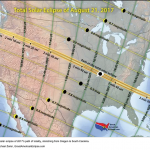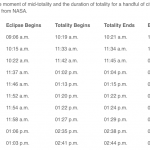US total solar eclipse 2017: When, where and how to see it (safely)
On Aug. 21, 2017, America will fall under the path of a total solar eclipse.
The so-called Great American Total Solar Eclipse will darken skies all the way from Oregon to South Carolina, along a stretch of land about 70 miles (113 kilometers) wide. People who descend upon this “path of totality” for the big event are in for an unforgettable experience.
Here is Space.com’s complete guide to the 2017 total solar eclipse. It includes information about where and when to see it, how long it lasts, what you can expect to see, and how to plan ahead to ensure you get the most out of this incredible experience.
REMEMBER: During totality, when the sun’s disk is completely covered by the moon, it is safe to view the eclipse with the naked eye. But skywatchers should NEVER look at a partial solar eclipse without proper eye protection. Looking directly at the sun, even when it is partially covered by the moon, can cause serious eye damage or blindness. See our complete guide to find out how to view the eclipse safely.
What is a total solar eclipse?
A total solar eclipse occurs when the disk of the moon appears to completely cover the disk of the sun in the sky. The fact that total solar eclipses occur at all is a quirk of cosmic geometry. The moon orbits an average of 239,000 miles (385,000 kilometers) from Earth — just the right distance to seem the same size in the sky as the much-larger sun. However, these heavenly bodies line up only about once every 18 months.
Outside the path of totality, skywatchers in the continental U.S. and other nearby areas will see a partial solar eclipse, in which the moon appears to take a bite out of the sun’s disk. Two to five solar eclipses occur each year on average, but total solar eclipses happen just once every 18 months or so.
What will I see during a total solar eclipse?
During a total solar eclipse, the disk of the moon blocks out the last sliver of light from the sun, and the sun’s outer atmosphere, the corona, becomes visible. The corona is far from an indistinct haze; skywatchers report seeing great jets and ribbons of light, twisting and curling out into the sky.
“It brings people to tears,” Rick Fienberg, a spokesperson for the American Astronomical Society (AAS), told Space.com of the experience. “It makes people’s jaw drop.”
During totality, the area inside the moon’s shadow is cloaked in twilight — a very strange feeling to experience in the middle of the day. Just before and just after totality, observers can see this cloak of darkness moving toward them across the landscape, and then moving away.
These effects are not visible during a partial solar eclipse, so skywatchers are encouraged to see if they are inside the path of totality during the total eclipse.
Where will the total solar eclipse be visible?
The path of totality for the Aug. 21, 2017, total solar eclipse is about 70 miles wide and stretches from Oregon to South Carolina. It passes through Idaho, Wyoming, Nebraska, Kansas, Missouri, Illinois, Kentucky, Tennessee, Georgia, North Carolina and South Carolina.
You can use this interactive map from NASA to zoom in on the path and find out the exact locations from which it will be visible.
You can also check out our state-by-state guide to find out which major cities and prime locations will fall inside the path of totality. You may also want to attend one of the many eclipse parties and organized events taking place around the path of totality.
When will the total solar eclipse occur, and how long will it last?
The timing of the total solar eclipse and its duration both depend on where you are inside the path of totality.
At most, the moon will completely cover the disk of the sun for 2 minutes and 40 seconds. That’s about how long totality will last for observers positioned anywhere along the center of the path of totality. As you move toward the edge of the path, the duration of totality will decrease. People standing at the very edge of the path may observe totality for only a few seconds.
The chart attached lists the moment of mid-totality and the duration of totality for a handful of cities that lie close to the center of the path. Data from NASA.
Because the shadow of the moon will move from west to east, totality will occur later in the day the farther east you travel. Use the NASA interactive eclipse map to find out exactly when totality will occur and how long it will last in the location where you plan to observe the eclipse. Just click on a spot on the map, and an informational box will appear with specific times.
Do I need any equipment to view the eclipse?
Anyone planning to view the total solar eclipse of 2017 should get a pair of solar viewing glasses. These protective shades make it possible for observers to look directly at the sun before and after totality. The following four companies sell eclipse glasses that meet the international standard (ISO 12312-2) recommended by NASA, the AAS and other scientific organizations: Rainbow Symphony, American Paper Optics, Thousand Oaks Optical, Lunt Solar Systems and TSE 17.
Sunglasses cannot be used in place of solar viewing glasses. See our complete guide to find out how to view the eclipse safely at web link below.
IMAGE: The total solar eclipse of 2017’s path of totality, stretching from Oregon to South Carolina.
Credit: Michael Zeiler, GreatAmericanEclipse.com
For more on this story and where you see livestream go to: https://www.space.com/33797-total-solar-eclipse-2017-guide.html
Related:
Eclipse FAQ: How big of a temperature drop can be expected?
by NASA From ABC News
IMAGE: (MGN)
Typically, how big a temperature drop do you get during a total solar eclipse?
ANSWER: It would probably be equal to the typical daytime minus nighttime temperature difference at that time of year and location on the Earth.
It would be modified a bit by the fact that it only lasts a few minutes, which means the environment would not have had much time to thermally respond to its lowest temperature, so it would probably only be 3/4 or 1/2 the maximum day-night temperature difference.
Because the patch of the shadow travels faster than the speed of sound, weather systems will only be affected very locally directly under the instantaneous footprint of the eclipse.
The main effect is in the “radiant heating” component which goes away suddenly at the moment of eclipse and produces a very fast temperature decrease. If the wind is blowing, your body probably exaggerates (by evaporative cooling) how large the actual temperature swing actually is.
For more on this story go to: http://abcnews4.com/features/2017-solar-eclipse/eclipse-faq-how-big-of-a-temperature-drop-can-be-expected








